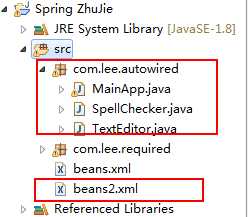Spring 注解之@Autowired、@Qualifer以及@Resource的区别
Posted
tags:
篇首语:本文由小常识网(cha138.com)小编为大家整理,主要介绍了Spring 注解之@Autowired、@Qualifer以及@Resource的区别相关的知识,希望对你有一定的参考价值。
参考技术A 1.Spring怎么知道注入哪个实现?如果Spring配置了component scan,并且要注入的接口只有一个实现的话,那么spring框架可以自动将interface于实现组装起来。
如果没有配置component scan,那么你必须在application-config.xml(或等同的配置文件)定义这个bean。
2.需要@Qualifier和@Resource注解吗?
一旦一个接口有多个实现,那么就需要每个特殊化识别并且在自动装载过程中使用@Qualifier和@Autowired一起使用来标明。
如果是使用@Resource注解,那么你应该使用resource中属性名称来标注@Autowired.
3.为什么@Autowired使用在interface上而不是实现类上?
首先,一般使用接口是很常用并且有益的变成技术。其次,在spring中,你可以在运行过程中注入各种实现。一个很经典的情况就是在测试阶段,注入模拟的实现类。
举个栗子:
@Autowired
private MessageService messageService; //MessageService 是接口
@Autowired默认按类型装配(这个注解是属业spring的),默认情况下必须要求依赖对象必须存在,如果要允许null值,可以设置它的required属性为false,如:@Autowired(required=false)
还有还有...
当接口存在两个实现类的时候必须使用@Qualifier指定注入哪个 接口实现类 ,否则可以省略,只写@Autowired。
举个栗子:
@Autowired
@Qualifier(value="messageServiceImpl")//这里 假设MessageService接口存在两个实现类 的时候,所以必须使用@Qualifier 指定注入哪个实现类
private MessageService messageService;
@Resource 是JDK1.6支持的注解 , 默认按照名称进行装配 ,名称可以通过name属性进行指定,如果没有指定name属性,当注解写在字段上时,默认取字段名,按照名称查找,如果注解写在setter方法上默认取属性名进行装配。当找不到与名称匹配的bean时才按照类型进行装配。但是需要注意的是,如果name属性一旦指定,就只会按照名称进行装配。
举个栗子:
@Resource(name="messageServiceImpl") //messageServiceImpl 是接口messageService的实现类
private MessageService messageService;
Spring基于注解的配置之@Autowired
学习地址:https://www.w3cschool.cn/wkspring/rw2h1mmj.html
@Autowired注释
@Autowired注释对在哪里和如何完成自动连接提供了更多的细微控制。
Setter方法中的@Autowired

SpellChecker.java:
package com.lee.autowired; public class SpellChecker { public SpellChecker() { System.out.println("Inside SpellChecker constructor"); } public void checkSpelling() { System.out.println("Inside checkSpelling"); } }
TextEditor.java:
package com.lee.autowired; import org.springframework.beans.factory.annotation.Autowired; public class TextEditor { private SpellChecker spellChecker; public SpellChecker getSpellChecker() { return spellChecker; } @Autowired public void setSpellChecker(SpellChecker spellChecker) { this.spellChecker = spellChecker; } public void spellCheck() { spellChecker.checkSpelling(); } }
MainApp.java:
package com.lee.autowired; import org.springframework.context.ApplicationContext; import org.springframework.context.support.ClassPathXmlApplicationContext; public class MainApp { public static void main(String[] args) { ApplicationContext context = new ClassPathXmlApplicationContext("Beans2.xml"); TextEditor td = (TextEditor) context.getBean("textEditor"); td.spellCheck(); } }
Beans2.xml:
<?xml version="1.0" encoding="UTF-8"?> <beans xmlns="http://www.springframework.org/schema/beans" xmlns:xsi="http://www.w3.org/2001/XMLSchema-instance" xmlns:context="http://www.springframework.org/schema/context" xsi:schemaLocation="http://www.springframework.org/schema/beans http://www.springframework.org/schema/beans/spring-beans-3.0.xsd http://www.springframework.org/schema/context http://www.springframework.org/schema/context/spring-context-3.0.xsd"> <context:annotation-config /> <bean id="textEditor" class="com.lee.autowired.TextEditor"></bean> <bean id="spell" class="com.lee.autowired.SpellChecker"></bean> </beans>
属性中的@Autowired属性
只有TextEditor不一样:
package com.lee.autowired2; import org.springframework.beans.factory.annotation.Autowired; public class TextEditor { @Autowired private SpellChecker spellChecker; public TextEditor() { System.out.println("Inside TextEditor constructor"); } public SpellChecker getSpellChecker() { return spellChecker; } public void spellCheck() { spellChecker.checkSpelling(); } }
构造函数中的@Autowired属性
package com.lee.autowired2; import org.springframework.beans.factory.annotation.Autowired; public class TextEditor { private SpellChecker spellChecker; @Autowired public TextEditor(SpellChecker spellChecker) { this.spellChecker=spellChecker; System.out.println("Inside TextEditor constructor"); } public void spellCheck() { spellChecker.checkSpelling(); } }
以上是关于Spring 注解之@Autowired、@Qualifer以及@Resource的区别的主要内容,如果未能解决你的问题,请参考以下文章